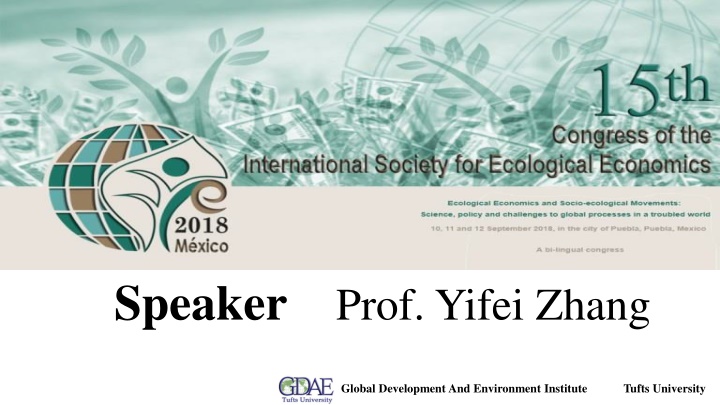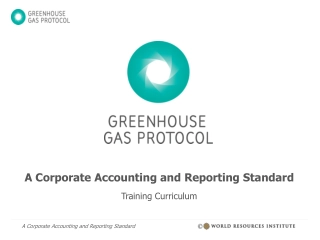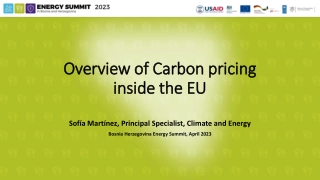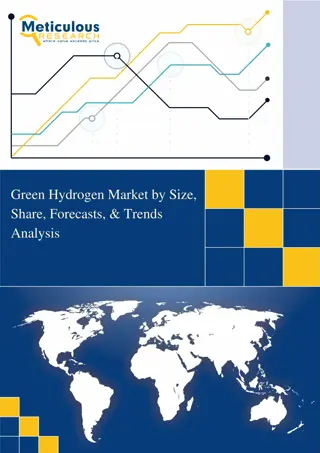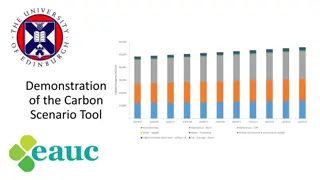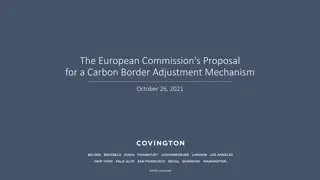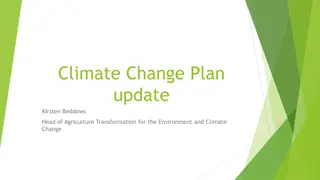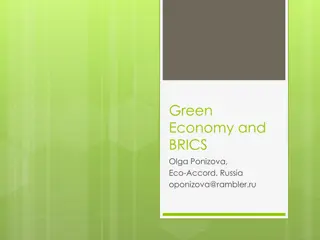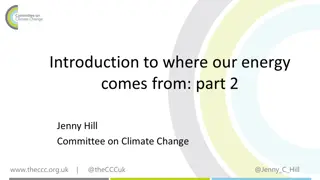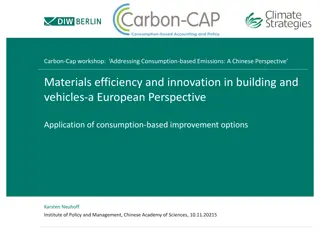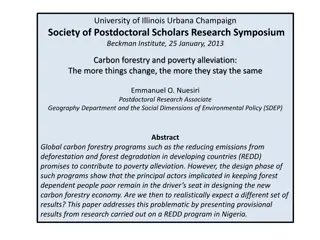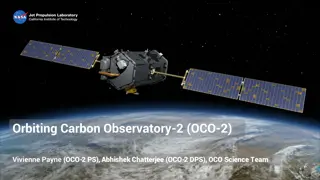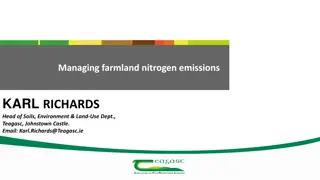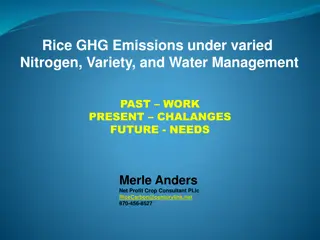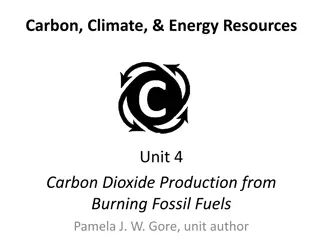Chinas Carbon Market: Accelerating a Green Economy and Reducing Global Emissions
This content discusses the progress and performance of the Carbon Emission Trading System Pilot in China, highlighting the total carbon dioxide reduction, the opening of carbon trading markets in various cities, and the methods used to allocate carbon emission quotas. It also touches on potential impacts on enterprise incentives for emission reductions and provides insights into the allocation of quotas in different industries within pilot areas.
Download Presentation

Please find below an Image/Link to download the presentation.
The content on the website is provided AS IS for your information and personal use only. It may not be sold, licensed, or shared on other websites without obtaining consent from the author.If you encounter any issues during the download, it is possible that the publisher has removed the file from their server.
You are allowed to download the files provided on this website for personal or commercial use, subject to the condition that they are used lawfully. All files are the property of their respective owners.
The content on the website is provided AS IS for your information and personal use only. It may not be sold, licensed, or shared on other websites without obtaining consent from the author.
E N D
Presentation Transcript
Speaker Prof. Yifei Zhang Global Development And Environment Institute Tufts University
Chinas Carbon Market: Accelerating a Green Economy in China and Reducing Global Emissions Yifei Zhang, Jonathan Harris, and Jin Li September 2018 Global Development And Environment Institute Tufts University 2
1.1 The Progress and Performance of the Carbon Emission Trading System Pilot A total of 197 million tons of carbon dioxide, equivalent with a total value of 4.5 billion yuan 666.5 million Carbon trading markets in Beijing, Shanghai, Tianjin, Chongqing, Hubei, Guangdong and Shenzhen were all opened Notice on Pilot Work on Carbon Emissions Trading issued 2011 2014 Sept, 2017 Global Development And Environment Institute Tufts University
1.1 The Progress and Performance of the Carbon Emission Trading System Pilot Figure 1: Number of emission control enterprises 947 1000 900 811 800 700 600 500 400 310 271 244 300 200 109 100 0 Beijing Guangdong Tianjin Shenzhen Shanghai Fujian Source: Carbon trading website Global Development And Environment Institute Tufts University
1.1 The Progress and Performance of the Carbon Emission Trading System Pilot May r e d u c e s t h e i n c e n t i v e of some enterprises for emissions reductions Industry Benchmark Historical Intensity Method Three primary methods used to allocate Currently, most carbon emission quotas in China are allocated for free by using the historical emission method Historical Emission Method Global Development And Environment Institute Tufts University
Table 1: Allocation of quotas in various industries in the pilot areas Method Shanghai Guangdong Hubei Fujian cement, electrical power, thermal power, the thermoelectric coupling electricity generation, power grid and heat supply and other electric heating industries power generation, cement, electrolytic aluminum, flat glass Industry Benchmark cement, electricity, steel comprehensive utilization of power industry resources generating units and heating boilers power grid, copper smelting, steel, chemicals, crude oil processing aviation, port, water transportation, tap water production and other industries Historical Intensity Method Others Comprehensive utilization of resources in the power industry with generating units and mining industry, glass, building materials, ceramics Historical Emission Method product complex enterprises ceramics for daily use Source: Carbon Allowance Allocation Policy issued by the pilot areas Global Development And Environment Institute Tufts University
1.1 The Progress and Performance of the Carbon Emission Trading System Pilot Figure 2: Carbon prices in emission trading market pilot Figure 3: Volume of carbon trading (RMB) Amount Volume Beijing Shanghai Guangdong Tianjin 1000.00 60.00 Shenzhen Hubei Chongqing Fujian 898.16 900.00 90 50.00 Volume(million tons) Amount(million yuan) 800.00 80 700.00 40.00 70 Carbon price(RMB/ton) 600.00 60 463.16 500.00 30.00 50 357.41 400.00 40 20.00 30 300.00 220.73 20 200.00 10.00 104.99 10 58.11 100.00 25.89 13.27 0 0.00 0.00 2014/1/28 2014/3/28 2014/5/28 2014/7/28 2014/9/28 2015/1/28 2015/3/28 2015/5/28 2015/7/28 2015/9/28 2016/1/28 2016/3/28 2016/5/28 2016/7/28 2016/9/28 2017/1/28 2017/3/28 2017/5/28 2017/7/28 2017/9/28 2013/11/28 2014/11/28 2015/11/28 2016/11/28 Source: http://k.tanjiaoyi.com/ Source: http://k.tanjiaoyi.com/ Global Development And Environment Institute Tufts University
1.2 Carbon Trading Pilot Assessment Beijing Tianjin (1) In the years from 2013 to 2015, Beijing ETS achieved respectively 0.41 million tons, 1.55 million tons and 2.9 million tons of CO2 emission reductions, accounting for 0.60%, 2.25% and 4.19% of the baseline CO2 emissions respectively. (1) The pilot carbon trading project in Tianjin would reduce carbon emissions by 0.62% (1.03 million tons) started from 2014. (2) Several problems A. the initial pricing is too high B. incomplete quota policy creates a large trading risk C. Mostly are state-owned enterprises which had less incetive D. Marginal reduction costs are lower than the high carbon prices (2) The total reduction was 4.87 million tons in three years In terms of overall operating efficiency, Yongwei Cheng (2017) used the DEA model to evaluate the operating efficiency of China's pilot carbon market. The results show that The carbon price level in Shenzhen is the highest and the most stable, while Guangdong and Hubei have the fastest growth in trading activity. Global Development And Environment Institute Tufts University
1.2 Carbon Trading Pilot Assessment DEA MODEL CARBON PRICE LEVEL The carbon price level in Shenzhen is the highest and the most s t a b l e , w h i l e Guangdong and Hubei have the fastest growth in trading activity DEA-EFFCIENT The carbon markets in Shenzhen, Hubei and Tianjin are DEA-efficient with the market efficiency of Shanghai, Beijing, G u a n g d o n g a n d Chongqing following in descending order. Global Development And Environment Institute Tufts University
2.1 Chinas Contribution to Global Carbon Emission Reduction The Kyoto Protocol initiated the concept of Emission Trading Scheme (ETS) The European Union formally implemented an ETS in 2005 China's carbon market makes global carbon emssion trading more optimistic California, Quebec, Switzerland, New Zealand and South Korea have also initiated carbon-trading schemes China's carbon market expected trading volume will still be larger than the existing carbon market in the EU Global Development And Environment Institute Tufts University
2.2 Carbon Trading: Deepening China's Supply-side Structural Reform Emission Trading Systems (ETS) Giving enterprises greater autonomy to choose between reducing their emissions or purchasing permits from participants involved in emissions reduction. Expanded from the initially covered enterprises to other firms, non-governmental organizations, and financial institutions. Global Development And Environment Institute Tufts University
2.3 Carbon Market: Extending the Process of Market Allocation of Ecological Factors The low or even zero price of ecological functions and services in the economic system are the fundamental cause of the imbalance between ecological conservation and economic development. 1.A significant economic policy tool for China to fulfill its responsibilities in responding to climate change 2.An important step towards China fully implementing market mechanisms in A national carbon market has been fully launched in China after the 19th Party Congress of China and the Bonn Climate Summit (COP23) ecological environmental management. Global Development And Environment Institute Tufts University
2.4 Promoting Targeted Poverty Alleviation and Balanced Development The 19th session of the national congress of the Communist Party of China (CPC) stressed 01 winning the fight against poverty as an important goal to improve livelihoods. Forest Take advantage of the trading system to 02 develop low-carbon and green agriculture farming patterns Global Development And Environment Institute Tufts University
3. Suggestions on Improving the Performance of China's Carbon Market Differences in the costs of carbon trading (1) Production heterogeneity of similar power generation enterprises (2) Heterogeneity of various enterprises energy structures (3) Emission reduction costs differ in different industries (4) Differences in the environmental costs of industrial emissions (5) Cost variability in reducing emissions between regions The world's largest carbon trading market Design the carbon trading market in terms of its economic characteristics, industrial development and regional differences Seven pilot projects trading volume is still small (1) Divided areas (2)Small generator exited the market (3)Implementation in pilot areas has led to insufficient liquidity of carbon markets Differing regional emission costs in the electric power industry. (1) Promoted further (3) Align with mature markets (2) Integrated overall markets (4) Response to The Belt and Road Initiative
